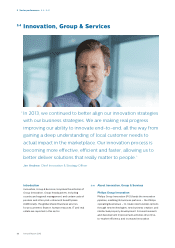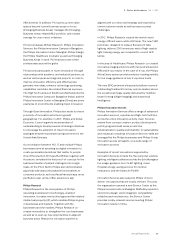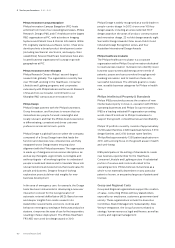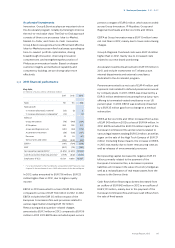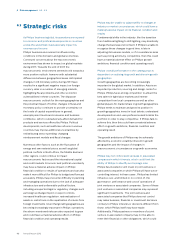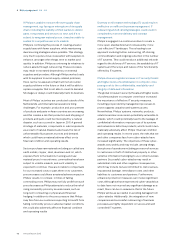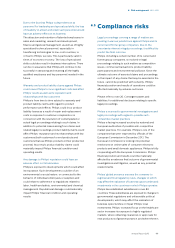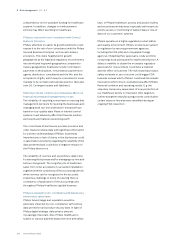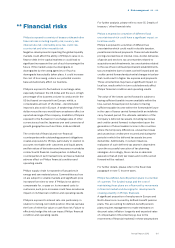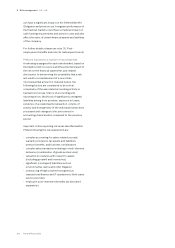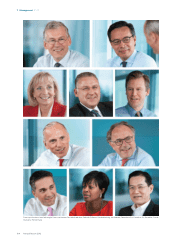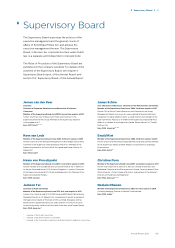Philips 2013 Annual Report Download - page 97
Download and view the complete annual report
Please find page 97 of the 2013 Philips annual report below. You can navigate through the pages in the report by either clicking on the pages listed below, or by using the keyword search tool below to find specific information within the annual report.6 Risk management 6.3 - 6.4
Annual Report 2013 97
expose Philips to additional financial or other
obligations, as well as have a material adverse eect on
the value of its investments in those entities or
potentially subject Philips to additional claims.
Acquisitions could expose Philips to integration risks
and challenge management in continuing to reduce the
complexity of the company.
Philips’ acquisitions may continue to expose Philips in
the future to integration risks in areas such as sales and
service force integration, logistics, regulatory
compliance, information technology and finance.
Integration difficulties and complexity may adversely
impact the realization of an increased contribution from
acquisitions. Philips may incur significant acquisition,
administrative and other costs in connection with these
transactions, including costs related to the integration
of acquired businesses.
Furthermore, organizational simplification and
resulting cost savings may be difficult to achieve.
Acquisitions may also lead to a substantial increase in
long-lived assets, including goodwill. Write-downs of
these assets due to unforeseen business developments
may have a material adverse eect on Philips’ earnings,
particularly in Healthcare and Lighting, which have
significant amounts of goodwill (see also note 11,
Goodwill).
Philips’ inability to secure and retain intellectual
property rights for products, whilst maintaining overall
competitiveness, could have a material adverse eect
on its results.
Philips is dependent on its ability to obtain and retain
licenses and other intellectual property (IP) rights
covering its products and its design and manufacturing
processes. The IP portfolio is the result of an extensive
patenting process that could be influenced by a
number of factors, including innovation. The value of
the IP portfolio is dependent on the successful
promotion and market acceptance of standards
developed or co-developed by Philips. This is
particularly applicable to Consumer Lifestyle where
third-party licenses are important and a loss or
impairment could have a material adverse impact on
Philips’ financial condition and operating results.
6.4 Operational risks
Failure to deliver on the objectives of the
transformation programs.
In 2011 Philips started a very extensive transformation
program (Accelerate!) to unlock Philips’ full potential.
Accelerate! spans a time period of several years. Failure
to achieve the objectives of the transformation
programs may have a material adverse eect on the
mid and long term financial targets.
In addition the transformation program of the Finance
function may expose Philips to adverse changes in the
quality of its systems of internal control.
Failure to achieve improvements in Philips’ solution
and product creation process and/or increased speed
in innovation-to-market could hamper Philips’
profitable growth ambitions.
Further improvements in Philips’ solution and product
creation process, ensuring timely delivery of new
solutions and products at lower cost and upgrading of
customer service levels to create sustainable
competitive advantage, are important in realizing
Philips’ profitable growth ambitions. The emergence of
new low-cost competitors, particularly in Asia, further
underlines the importance of improvements in the
product creation process. The success of new solution
and product creation, however, depends on a number
of factors, including timely and successful completion
of development eorts, market acceptance, Philips’
ability to manage the risks associated with new
products and production ramp-up issues, the ability of
Philips to attract and retain employees with the
appropriate skills, the availability of products in the
right quantities and at appropriate costs to meet
anticipated demand and the risk that new products and
services may have quality or other defects in the early
stages of introduction. Accordingly, Philips cannot
determine in advance the ultimate eect that new
solutions and product creations will have on its financial
condition and operating results. If Philips fails to
accelerate its innovation-to-market processes and fails
to ensure that end-user insights are fully captured and
translated into solution and product creations that
improve product mix and consequently contribution, it
may face an erosion of its market share and
competitiveness, which could have a material adverse
eect on its financial condition and operating results.



